2025 Costs: Age-Friendly Universal Design Remodels
Aging in place ranks as a primary goal for numerous homeowners seeking sustained comfort and autonomy within their residences as years advance. Remodeling efforts informed by universal design principles yield environments that prioritize safety, accessibility, and ease of movement for individuals across diverse abilities. Grasping the financial implications of such transformations equips you to balance immediate needs with enduring benefits.
This resource delineates the essence of universal design in residential settings, outlines prevailing project expenses, identifies optimal budget allocations, and advises on engaging experts to uphold standards of excellence and security.
Average Costs of Age-Friendly Remodels
Expenses for a universal design overhaul hinge on factors like residence dimensions, current configuration, and scope of alterations required. The following outlines representative price brackets for prevalent initiatives:
- Comprehensive home-wide universal overhaul: $100,000 to $250,000, encompassing significant adaptations such as broadening corridors to 36 inches for wheelchair passage, installing zero-threshold entry showers, and reconfiguring layouts into fluid, open kitchens.
- Bathroom enhancements: $15,000 to $35,000, incorporating seamless-entry showers with fold-down benches, reinforced grab bars rated for 250 pounds, textured non-slip tiles, and toilets elevated to 17-19 inches for reduced strain.
- Kitchen modifications: $25,000 to $75,000, featuring adjustable-height counters at 34 inches, base cabinets with full-extension drawers for effortless reach, and appliances like side-opening ovens and front-control ranges.
- Entry modifications: $3,000 to $10,000, including portable or fixed ramps with 1:12 slope ratios, doorways expanded to 32 inches clear width, and motion-sensor lighting for hazard-free approaches.
- Bedroom accessibility enhancements: $8,000 to $20,000, involving built-in walk-in closets with 5-foot turning radii, pathways cleared to 36 inches, and automated lighting systems activated by voice or proximity.
These figures account for materials and labor alike. Regional differences and contractor expertise influence final tallies, yet strategic selections in design can curb outlays without compromising durability.
Budgeting and ROI Strategies
Prioritize expenditures on high-traffic zones to maximize utility. Bathroom and kitchen interventions yield superior functionality and elevate property appeal upon resale. Opt for resilient options like quartz surfaces that withstand stains and heat, luxury vinyl tiles mimicking wood with superior slip resistance, and composite materials for outdoor extensions that demand infrequent sealing.
Initiating accessibility measures during initial renovations proves more economical than subsequent adaptations. Integrating these elements with routine updates minimizes redundant efforts and labor charges. Secure detailed breakdowns from providers to track allocations precisely, and solicit proposals from no fewer than three specialists prior to commitment.
Consider financing through home equity lines or specialized loans for accessibility, which often carry favorable terms. Track potential returns by noting that universal features can boost home values by 5-10% in markets valuing inclusive living.
When to Hire a Professional
Engage a certified specialist for undertakings that touch upon plumbing, electrical systems, or structural integrity. Such endeavors necessitate approvals and evaluations to align with regulatory safety benchmarks. Experts versed in universal design principles can suggest solutions that harmonize compliance with visual elegance, such as concealed grab bar installations or integrated smart controls.
Structural adjustments, like removing non-load-bearing partitions or redirecting conduits, demand professional oversight to adhere to municipal codes. Simpler tasks, including fixture replacements or grab bar mounting, permit capable residents to proceed independently using basic implements and manufacturer guidelines.
Select contractors by confirming licensure, liability coverage, and endorsements from comparable assignments. Review portfolios of prior installations to assess alignment with your vision for seamless, stylish integration.
Maintenance and Longevity
Universal design components endure through intentional material choices. Select moisture-repellent finishes, abrasion-resistant coatings, and UV-stable exteriors to preserve integrity over decades. Textured flooring, corrosion-proof stainless fixtures, and weather-resistant composites require only routine cleaning to sustain performance.
Conduct yearly evaluations of mechanical elements, illumination arrays, and surface conditions to preempt failures. Promptly secure or substitute any compromised parts to avert risks.
For integrated technology, schedule firmware updates to ensure ongoing protection and interoperability. Organize documentation of specifications and guarantees in a dedicated file for streamlined future interventions.
Common Questions About Age-Friendly Remodels
What distinguishes universal design from accessible design?
Universal design accommodates everyone equitably through intuitive features, whereas accessible design targets accommodations for particular impairments. The former integrates more fluidly into everyday aesthetics.
Do accessibility remodels require permits?
Approvals apply to modifications affecting structure, water systems, or wiring. Surface-level changes like installing grab bars or upgrading lights typically bypass this, though verification with local authorities remains essential.
What financial aids exist for aging-in-place projects?
Certain municipal initiatives and wellness organizations provide subsidies or rebates. Inquire with your municipal housing authority or regional elder care division for eligibility criteria.
How to enhance stair safety affordably?
Install LED step lighting for visibility, apply high-contrast edge strips to treads, and mount continuous handrails at 34-38 inches height on opposing sides. These measures heighten security with modest investment.
Advancing Your Age-Friendly Transformation
Embarking on an age-friendly renovation secures enhanced daily ease, self-reliance, and protection. Develop a prioritized blueprint outlining essential modifications, then partner with adept professionals attuned to universal principles. Emphasize enhancements that elevate routine activities while safeguarding aesthetic appeal and asset worth.










